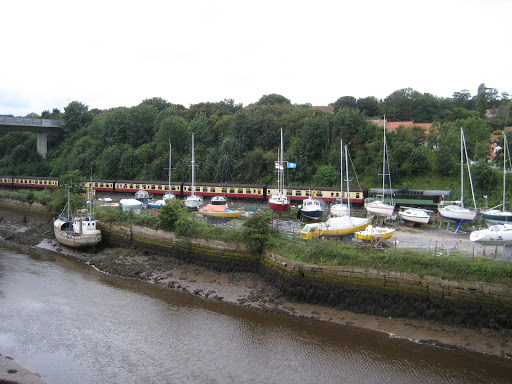We are just back from a week in Whitby where we stayed in a third-floor riverside apartment watching the clockwork of the tides, Northern Rail and the North Yorkshire Moors Railway (NYMR). It was not the usual kind of country cottage we stay in, but a wonderful location nevertheless, and an unexpected family holiday in a year when the offspring had planned things of their own.
Here are some pictures of the NYMR post-lockdown ‘Optimist’ service arriving from and departing for Pickering:
 | |
| Arriving with heritage diesel-electric locomotive D7628 ‘Sybilla’ at 11.00 on 18th August |
 |
| Leaving with 4-4-0 steam locomotive 926 ‘Repton’at 16.30 on the 19th August |
 |
| Leaving with the unnamed 4-6-0 locomotive 825 at 16.30 on the 21st August |
I love the NYMR heritage railway. It runs for eighteen miles through the North York Moors National Park from Pickering to Grosmont. At the northern end, trains can then join Network Rail tracks to run the six miles from Grosmont through to Whitby. Regrettably, the eight miles of track connecting Pickering to Malton at the southern end was lifted after the Beeching cuts of the nineteen-sixties. If still in place, trains would be able to run all the way from York to Whitby without having to go round by Middlesbrough, which would be very popular. Hopefully, one day it will happen.
In past years we have had many happy days out on the NYMR. We have driven to Pickering, caught the train to Grosmont, eaten in the pub, walked back to Goathland and returned on the train to Pickering. We have done a similar walk between Newton Dale Halt and Levisham station. We once used it to visit to Whitby. A lot of people like to visit Goathland as the location of Aidensfield in the television series ‘Heartbeat’ which is set in the nineteen-sixties, and its railway station appears in the ‘Harry Potter’ films as Hogsmeade station.
You can do all of this, of course, by car, which costs a lot less, but that way you don’t get to ride on a steam train. Some love it so much they just travel back and forth along the line. We’ve done that too. I could spend all day just watching the wooden railway gates at Grosmont: proper swinging gates that make a satisfying clunk when they come to rest against their wedges. Here are some past pictures.
 |
| Grosmont, August 2002 |
 |
| Goathland, July 2014 |
 |
| Grosmont, July 2014 |
 |
| Grosmont, July 2017 |
Last week was the first time we have stayed in the area without visiting the railway. They have had to introduce COVID-safe restrictions, such as non-stop services and pre-booked seats only, making it difficult and inconvenient. I don’t know whether there is any more risk of catching the virus on a train than in walking the crowded streets of Whitby, Scarborough or Staithes, which we did. If, say, one in twenty thousand people is infectious, then you would be unlucky to encounter it at all, and even unluckier to catch it.
The trouble is that lots of small risks combine to make bigger risks, so that if an infectious person is around in the community they could easily infect someone, somewhere. You just have to hope it won’t be you. I suppose that one infected person on a train could infect several others, whereas in the street, provided you and most others are sensible, you would only be near that person for one brief moment in which you are unlikely to get it. I really do not want to catch it. Even those with so-called mild cases, such as the son of one of my cousins, a fit young man in his thirties, have had unpleasant and worrying symptoms persisting for months.
Anyway, I didn’t just think about trains. I thought about boats as well. Even Mrs. D. was fascinated by the activities on the river and in the boatyard:
“Look! There’s a gap now next to the greeny-yellow one. I wish we’d seen them lifting it back into the water. And there’s a chap with a hose pipe on top of that black and white one [see first picture]. And that couple are still on the white boat this morning. They must have been there all night.”
What fun to have a little boat moored at Whitby to live on board whenever you fancy a few days away.
I became especially interested in the boat resting on the mud bank in the first picture. She usually re-floated at high tide but not always. One morning she stayed on the bottom with water over the sides and spouted like a leaking kettle as the tide went out. But hoo-ray and up she rises come the next tide.
 |
| 06:00 a.m. 20th August |
 |
| Later the same morning - 09:30 a.m. 20th August |
 |
| The following day - 07:00 a.m. 21st August |
Ignoring ridicule from my family (“Oh no! He’s obsessed with clapped out boats as well as clapped out trains!”), I walked round over Whitby swing bridge to take a closer look. The boat turned out to be Sunderland-registered trammel net trawler SD403 ‘Our Mellissa’, built in Denmark in 1979, previously named the Norlan and the Kraefrihed, which seems to have been active in Whitby until around 2016. Here she is with our ‘Whitehall Landing’ apartments across the river (on the site of a former shipyard, they were supposedly designed to look like traditional dockside warehouses), and in happier times in Whitby Harbour in 2010.
 |
| SD403 Our Mellissa at Whitby, 20th August 2020 |
 |
| SD403 Our Mellissa in Whitby Harbour 2010 |
I didn’t just think about boats either. The North York Moors around Whitby is wonderful walking country, but that’s another post.






